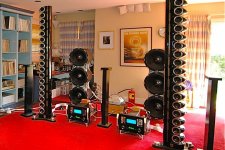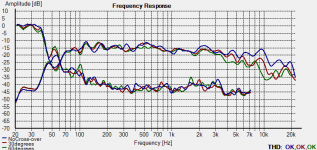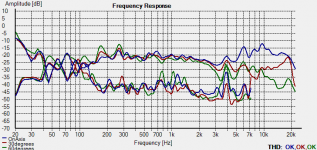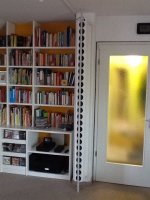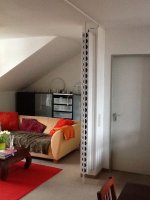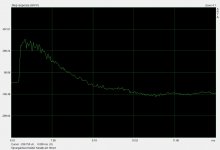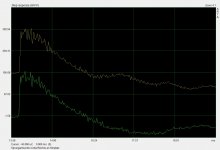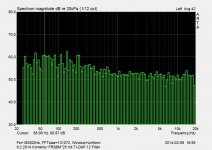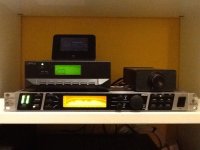That had crossed my mind gmad, you might be right there.
But while you're here, care to try that small knee at ~ 1.5 KHz with your setup?
Just to see (or actually hear) if "Depth" perception changes. I'd advice to not have the speakers on axis for this test. Aim them in a way that they cross behind you. That should maximise the perception I.M.H.O.
Well, since my speakers are on-axis right now, that would require new sweeps/filters so you'll need to allow me some time for that one
I've tried Kat'z tilt with the 1khz knee, but I didn't like (and don't understand) it. The only non-flat target I've ever enjoyed long term was a 0.5 - 0.6db/octave tilt starting at a low frequency. However, ever since I ran sweeps with the mic on-axis for each speaker, I've been enjoying all recordings played "flat".
Some recordings definitely seem to have more depth with a tilted target (Deutsche Grammophon) while others sound best with a flat target (Telarc), but I don't want to open the multiple-target can of worms and I'd rather err on the side of "lean" than "overly thick".
I have tried that "surround" effect also. It is by far one of the most effective effects I have used to exact sound field ambient information without wrecking the clarity or precise 3D placement of the recorded music. Well done JRiver. I am going to get some sleep, and add some of my experiences later.
Allen
Missed that one on the first read of your post... Nice huh? All I can say it works very well with the arrays. Can't vouch for other type of speakers though.
It didn't make my stage wider, but it made the sides more clear, that is, the sides about 1.5 meter past the outside of speakers(!)
On some songs you get the feeling they are almost breathing down your neck from the sides. Like the (bit creepy sounding) Frank Zappa song: Find her Finer from the Hot Rats album.
Well, since my speakers are on-axis right now, that would require new sweeps/filters so you'll need to allow me some time for that one.
I've tried Kat'z tilt with the 1khz knee, but I didn't like (and don't understand) it. The only non-flat target I've ever enjoyed long term was a 0.5 - 0.6db/octave tilt starting at a low frequency. However, ever since I ran sweeps with the mic on-axis for each speaker, I've been enjoying all recordings played "flat".
Some recordings definitely seem to have more depth with a tilted target (Deutsche Grammophon) while others sound best with a flat target (Telarc), but I don't want to open the multiple-target can of worms and I'd rather err on the side of "lean" than "overly thick".
Take your time, no problem. The knee doesn't have to be extreme like the bob Katz example, just make ~1.5 KHz somewhat hotter, gradually declining on both sides. That doesn't disturb the tonal balance and works well for me. You could easily try with the suggested PEQ filter I mentioned... Just rotate the speakers a little, tap in the PEQ and if something changes it's worth pursuing
How is your stage, does it extend way past the speakers on some songs? Depending on the recording of coarse. I get about a 150 degree soundstage with eyes closed and cannot pin point the speakers position at any time.
Just hearing a soundscape before me, you forget the speakers, the true disappearing act. I've seen your measurement but don't remember reading subjective impressions like these.
With eyes open I still hear the sound past the speakers but our eyes are stronger than the ears (at least mine are) and it's distracting. I don't like staring into my blank TV screen... At night it works with dim lights though. Maybe I should have anodised the aluminium black
Last edited:
Hi marin.weigel,
Since the microphone I use (EMM-6) is not truly omnidirectional, I have to make a choice when performing measurements whether to favor the direct or reflected sound (or split the difference). I choose (as of now) the former because in my room, with my set-up, the direct sound arrives a few ms earlier and more than a few db louder than the reflections. Also, I like to correct (with DRC) an aggressively windowed version of the measurement which practically excludes the reflections above the Schroeder frequency.
Hi koldby,
My understanding is that even if we are measuring a perfectly omnidirectional speaker, the mic (unless perfectly omnidirectional itself) still needs to be aimed at it in order to "hear" the speaker accurately. In the case of an array, I understand that any microphone angle >270deg and <90deg is technically pointing at the speaker, but don't the drivers at ear-level (0 deg) dominate?
Since the microphone I use (EMM-6) is not truly omnidirectional, I have to make a choice when performing measurements whether to favor the direct or reflected sound (or split the difference). I choose (as of now) the former because in my room, with my set-up, the direct sound arrives a few ms earlier and more than a few db louder than the reflections. Also, I like to correct (with DRC) an aggressively windowed version of the measurement which practically excludes the reflections above the Schroeder frequency.
Hi koldby,
My understanding is that even if we are measuring a perfectly omnidirectional speaker, the mic (unless perfectly omnidirectional itself) still needs to be aimed at it in order to "hear" the speaker accurately. In the case of an array, I understand that any microphone angle >270deg and <90deg is technically pointing at the speaker, but don't the drivers at ear-level (0 deg) dominate?
Just looked at my Behringer ECM 8000 model plots at 0, 45 and 90 degree and the same plot for the Dayton EMM-6.
There are remarkable differences at angles, the Behringer ECM 8000 (not my sample):

Compared to the Dayton EMM-6:

I wouldn't use either of them at 90 degree. But pointing straight forward or slightly up as I do seems to limit the margin of error quite well.
Calibration is key if we're looking at this level. I haven't tried my other uncallibrated mic yet. Maybe I should try and calibrate that one against the calibrated mic to have a genuine spare.
There are remarkable differences at angles, the Behringer ECM 8000 (not my sample):

Compared to the Dayton EMM-6:

I wouldn't use either of them at 90 degree. But pointing straight forward or slightly up as I do seems to limit the margin of error quite well.
Calibration is key if we're looking at this level. I haven't tried my other uncallibrated mic yet. Maybe I should try and calibrate that one against the calibrated mic to have a genuine spare.
Last edited:
Take your time, no problem. The knee doesn't have to be extreme like the bob Katz example, just make ~1.5 KHz somewhat hotter, gradually declining on both sides. That doesn't disturb the tonal balance and works well for me. You could easily try with the suggested PEQ filter I mentioned... Just rotate the speakers a little, tap in the PEQ and if something changes it's worth pursuing.
How is your stage, does it extend way past the speakers on some songs? Depending on the recording of coarse. I get about a 150 degree soundstage with eyes closed and cannot pin point the speakers position at any time.
Just hearing a soundscape before me, you forget the speakers, the true disappearing act. I've seen your measurement but don't remember reading subjective impressions like these.
With eyes open I still hear the sound past the speakers but our eyes are stronger than the ears (at least mine are) and it's distracting. I don't like staring into my blank TV screen... At night it works with dim lights though. Maybe I should have anodised the aluminium black.
I'd say my soundstage width might reach 100 degrees with a few recordings? Sometimes the temperature might also reach 100 degrees if I forget to run the air conditioner
I definitely agree that nighttime with eyes closed lends itself to a deeper level of hearing; I perceive total transparency of the sound with good recordings - speakers absolutely disappear. There can be a nice sense of depth although not usually a large amount....
All in all, a very big and transparent sound that sometimes lets me forget I'm in such a small space listening to (tiny) speakers...
Just looked at my Behringer ECM 8000 model plots at 0, 45 and 90 degree and the same plot for the Dayton EMM-6.
There are remarkable differences at angles, the Behringer ECM 8000 (not my sample):

Compared to the Dayton EMM-6:

I wouldn't use either of them at 90 degree. But pointing straight forward or slightly up as I do seems to limit the margin of error quite well.
Calibration is key if we're looking at this level. I haven't tried my other uncallibrated mic yet. Maybe I should try and calibrate that one against the calibrated mic to have a genuine spare.
Excatly my point.
I believe the error pointing the measuring mike between the two speakers introduce so little error that it is of no importance.
An omniderectional mike is far better in beeing just that (omnidirectional) than the common so called point source loudspeakers. If it is not an dedicated omindirectional design, they become more and more directional as the frequency rises, makeing it difficult to make correct in room measurements.
Line sources have more uniform dispersion throughout the frequency spectrum.
Koldby
And for those that think the TC9 doesn't have enough DDR, try 50 of them.
40 give great immersion too
Thank you for dropping in, marin. I'd say that truly does say something about the DIY effort. What were the listening impressions if you compare those two?
Do you use (P)EQ only? Have you tried FIR based processing?
I'll go experiment with mic positions one of the next times. Although I must say my microphone did pick up on the reflections coming from behind it. I usually point it a bit upwards and have it at the (referring to me) listeners ear height.
I use a Raspberrypi with LMS and Squeezebox Touch with modified Kernel, do PEQ with a Behringer DEQ24/96 and go through a DIY DAC with volume pot to the power amp.
With the exception of the Behringer and using an active filter and extra amp for the T4A's, I had the same setup.
The DIY line sources have way better dynamics, much more precise imaging and three dimensionality, a lot more jump factor, sound more realistic at any volume!
Throughout the room, the sound scape is far more stable, sweet spot is very large.
The only thing I dearly miss is the true ribbon tweeter ...
My 8 year old mac mini has just been taken off duty as "the" PC, and I might well try it as a base to test something along your lines!
Regards, Marin
I can imagine that ribbon tweeter being better than a line of full rangers that are obviously playing beyond their true potential up high. I'd love to hear the Scaena in real life, they bring the tweeter line in at ~5500 Hz... If only funds would allow to play with it, just to hear the differences...
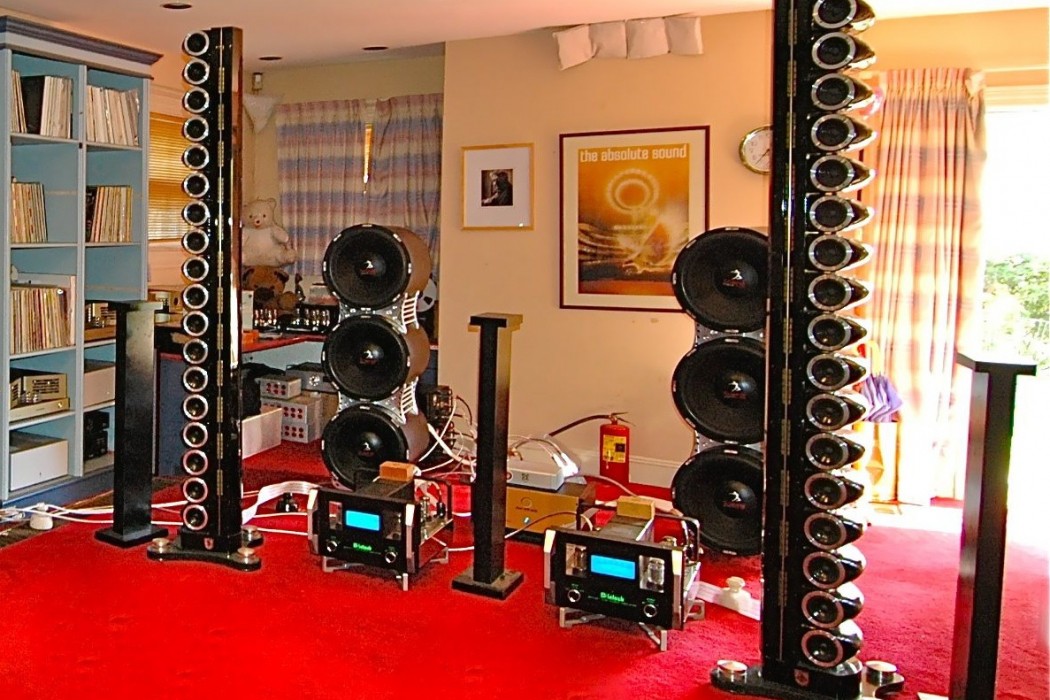
Not that I'm unhappy though, and I may not have reached the highest potential yet. Still a lot more to try. And probably part of the magic here is the coherence of the full range array. I'm not nearly done experimenting and still booking progress. I do believe FIR filters to be more powerful than PEQ. But like with everything, handle with care.
Do you have a picture of your Arrays? I think I've seen an interesting avatar from you on another forum .
.
For now I'm extremely pleased with what I hear, played a couple of songs today and the magic is still there. Time to let it sink in and enjoy it for a while.
I haven't even brought my baffle fixture back in original state yet, which I know was a tiny bit better. No hurry with sound like this.
Not that I'm unhappy though, and I may not have reached the highest potential yet. Still a lot more to try. And probably part of the magic here is the coherence of the full range array. I'm not nearly done experimenting and still booking progress. I do believe FIR filters to be more powerful than PEQ. But like with everything, handle with care.
Do you have a picture of your Arrays? I think I've seen an interesting avatar from you on another forum
For now I'm extremely pleased with what I hear, played a couple of songs today and the magic is still there. Time to let it sink in and enjoy it for a while.
I haven't even brought my baffle fixture back in original state yet, which I know was a tiny bit better. No hurry with sound like this.
Attachments
Last edited:
Lets find some soundstage...
I think we are really on to some really interesting discoveries here in this thread. I have always wondered what creates a 3D sound stage. I have noticed some systems have it, others do not. Certain drivers seem to have it, others don't. What gives??? I think we are uncovering some of the mysteries in this thread. Lets keep digging...
When I first started playing with JRiver and the PEQ and convolutions, I EQed for a measured flat response at my listening position. The sound was amazingly detailed, a sound I did not even think was possible with my NSB arrays. I did find it a tad "etched" as the highs lacked the smoothness of a good planar tweeter and there was a loss in overall 3D soundstage. The sound became more forward, I believe due to possible beaming of the highs. (more on that later). Yet the fidelity amazed me. At this point I realized any tonal balance I desired is now possible...
Upon taking a measurement one meter from one speaker, I found I naturally had a pretty flat response without EQ. (I did not have that before ) So I "re-listened" to the arrays flat. To my surprise, the detail was still there. I was so excited to try the DSP, that I did not even bother to listen without it in the beginning.
) So I "re-listened" to the arrays flat. To my surprise, the detail was still there. I was so excited to try the DSP, that I did not even bother to listen without it in the beginning.  Needless to say, I finally got my M-audio DAC "locked in" the way it is supposed to be. Again, hats off to JRiver. I purchased the software...
Needless to say, I finally got my M-audio DAC "locked in" the way it is supposed to be. Again, hats off to JRiver. I purchased the software...
We are told from a physics standpoint that all drivers start to beam at some point, the measurements below prove otherwise. I did on and off axis measurements of my Arrays and Avebury. line source (on left) -vs- true point source (on right). My degree placement is not exact, but close enough to validate this point. I am using a Dayton "Omni" measurement mic, noting some of the same issues discussed in the recent posts. The mic was pointing directly at the center of the drivers for all these measurements. I included the distortion readings just to reaffirm the possibilities of what a large quantity of cheap drivers can do working together.
I mentioned above that maybe "beaming" causes a loss in overall sound stage. Based on these measurements, that would not be the case. As many of You are preferring slow gradual roll-offs in the highs, maybe the highs do mask the spatial details in the 1 - 3 kHz region. I do notice when I create a 3 kHz, 24 dB/octave Low-pass crossover convolution in JRiver and use that on Avebury, that system completely disappears. There are no highs what so ever, but I can not localize those speakers at all. Again, I am not sure if this is caused by the beaming or shear lack of highs. I am going to set up a two-way system when I have enough time off work: Avebury crossed at 3 kHz to Hi Vi Pro planar tweeter. I will let You all know of the results of this test...
I also tried crossing the arrays at 3 kHz to see if they would disappear. They didn't. I do not quite experience the disappearing act Wesayso experiences with his arrays. But my cabinets are flat rectangles with sharp corners, and I do not have the rounded baffle covers to round off that 1/4 inch cardboard bezel frame that sticks out of each NSB driver. I would like to build nicer cabinets for these, but as it turns out, three of the drivers are damaged and there is a nasty break up around 1.2 kHz that EQ can not fix. (Not all of my DSP adventures were good.) EQ can do a lot, but it can not fix inherent driver problems. When I crossed these drivers lower, at 700 kHz, I could hear a quiet rubbing in the voice coils that sounds around where the break-up is. Maybe all the drivers are damaged. I do not know if I am hearing things, I just know that when I perform the same test with Avebury, it is not there. I tried figuring out a way to measure this, but I really do not know how to. Giving all these setbacks, these arrays do sound pretty good at moderate volume levels. But unfortunately, I will not be putting any more time into these arrays, so I am figuring out what to do for the next Array build. This is not a bad thing, as this was always an experimental build to begin with, I got my moneys worth from the experience.
I would like to build nicer cabinets for these, but as it turns out, three of the drivers are damaged and there is a nasty break up around 1.2 kHz that EQ can not fix. (Not all of my DSP adventures were good.) EQ can do a lot, but it can not fix inherent driver problems. When I crossed these drivers lower, at 700 kHz, I could hear a quiet rubbing in the voice coils that sounds around where the break-up is. Maybe all the drivers are damaged. I do not know if I am hearing things, I just know that when I perform the same test with Avebury, it is not there. I tried figuring out a way to measure this, but I really do not know how to. Giving all these setbacks, these arrays do sound pretty good at moderate volume levels. But unfortunately, I will not be putting any more time into these arrays, so I am figuring out what to do for the next Array build. This is not a bad thing, as this was always an experimental build to begin with, I got my moneys worth from the experience.
The surround settings did not change the depth or width of my sound stage either, but it did bring it out more. I will try it with Avebury to see if it performs in a similar fashion.
I have a close friend who is a big Zappa fan. I will have him bring some of his collection over, as I know the recording techniques on those albums is second to none.
One more thing:
...Relating back to the perception of soundstage. I noticed when playing with the convolutions, I needed to design my filters for the sampling rate of the source material. When ever I "over-sampled" the convolution, I found it made the treble smoother, but the soundstage became a straight line between the speakers, no depth, no width. I tried no convolution and did the up-sampling in the DAC, and the same thing happened. So I do not know if this is an up-sampling deal, or it is my M-Audio DAC not really being good at 96 kHz. I know we were talking about this earlier in this thread, and this is something I observed. I just hope my Buffalo DAC does not do this to the sound when it up-samples. Anyone else observe this?
So having said all of that, and being reaffirmed with many of my discoveries on this thread, I am on a mission to find a driver that has a flawless response between 1 kHz - 6 kHz. I was considering building a full-range ribbon driver, but seeing that it is possible to have a uniform dispersion pattern with 3-4 inch full-rangers, and that someone upgraded from a Magnapan system, maybe I will go that route...
I hope I was able to provide some useful information here...
Allen
I think we are really on to some really interesting discoveries here in this thread. I have always wondered what creates a 3D sound stage. I have noticed some systems have it, others do not. Certain drivers seem to have it, others don't. What gives??? I think we are uncovering some of the mysteries in this thread. Lets keep digging...
Give it a shot. I suspect that the "brightness" that people generally associate with a "flat" in-room response may be partially due to the use of an off-axis mic for the measurement.
When I first started playing with JRiver and the PEQ and convolutions, I EQed for a measured flat response at my listening position. The sound was amazingly detailed, a sound I did not even think was possible with my NSB arrays. I did find it a tad "etched" as the highs lacked the smoothness of a good planar tweeter and there was a loss in overall 3D soundstage. The sound became more forward, I believe due to possible beaming of the highs. (more on that later). Yet the fidelity amazed me. At this point I realized any tonal balance I desired is now possible...
Upon taking a measurement one meter from one speaker, I found I naturally had a pretty flat response without EQ. (I did not have that before
 ) So I "re-listened" to the arrays flat. To my surprise, the detail was still there. I was so excited to try the DSP, that I did not even bother to listen without it in the beginning.
) So I "re-listened" to the arrays flat. To my surprise, the detail was still there. I was so excited to try the DSP, that I did not even bother to listen without it in the beginning.  Needless to say, I finally got my M-audio DAC "locked in" the way it is supposed to be. Again, hats off to JRiver. I purchased the software...
Needless to say, I finally got my M-audio DAC "locked in" the way it is supposed to be. Again, hats off to JRiver. I purchased the software...I donn´t think this is (as much anyway) the case when it is a line array we are talking about.
The dispersion patterne is quite uniform through the freq. spectrum in line sources , whereas pointsource speakers tend to be more and more directive as the frequency rises.
Koldby
We are told from a physics standpoint that all drivers start to beam at some point, the measurements below prove otherwise. I did on and off axis measurements of my Arrays and Avebury. line source (on left) -vs- true point source (on right). My degree placement is not exact, but close enough to validate this point. I am using a Dayton "Omni" measurement mic, noting some of the same issues discussed in the recent posts. The mic was pointing directly at the center of the drivers for all these measurements. I included the distortion readings just to reaffirm the possibilities of what a large quantity of cheap drivers can do working together.
I mentioned above that maybe "beaming" causes a loss in overall sound stage. Based on these measurements, that would not be the case. As many of You are preferring slow gradual roll-offs in the highs, maybe the highs do mask the spatial details in the 1 - 3 kHz region. I do notice when I create a 3 kHz, 24 dB/octave Low-pass crossover convolution in JRiver and use that on Avebury, that system completely disappears. There are no highs what so ever, but I can not localize those speakers at all. Again, I am not sure if this is caused by the beaming or shear lack of highs. I am going to set up a two-way system when I have enough time off work: Avebury crossed at 3 kHz to Hi Vi Pro planar tweeter. I will let You all know of the results of this test...
I also tried crossing the arrays at 3 kHz to see if they would disappear. They didn't. I do not quite experience the disappearing act Wesayso experiences with his arrays. But my cabinets are flat rectangles with sharp corners, and I do not have the rounded baffle covers to round off that 1/4 inch cardboard bezel frame that sticks out of each NSB driver.
Missed that one on the first read of your post... Nice huh? All I can say it works very well with the arrays. Can't vouch for other type of speakers though.
It didn't make my stage wider, but it made the sides more clear, that is, the sides about 1.5 meter past the outside of speakers(!)
On some songs you get the feeling they are almost breathing down your neck from the sides. Like the (bit creepy sounding) Frank Zappa song: Find her Finer from the Hot Rats album.
The surround settings did not change the depth or width of my sound stage either, but it did bring it out more. I will try it with Avebury to see if it performs in a similar fashion.
I have a close friend who is a big Zappa fan. I will have him bring some of his collection over, as I know the recording techniques on those albums is second to none.
One more thing:
...Relating back to the perception of soundstage. I noticed when playing with the convolutions, I needed to design my filters for the sampling rate of the source material. When ever I "over-sampled" the convolution, I found it made the treble smoother, but the soundstage became a straight line between the speakers, no depth, no width. I tried no convolution and did the up-sampling in the DAC, and the same thing happened. So I do not know if this is an up-sampling deal, or it is my M-Audio DAC not really being good at 96 kHz. I know we were talking about this earlier in this thread, and this is something I observed. I just hope my Buffalo DAC does not do this to the sound when it up-samples. Anyone else observe this?
So having said all of that, and being reaffirmed with many of my discoveries on this thread, I am on a mission to find a driver that has a flawless response between 1 kHz - 6 kHz. I was considering building a full-range ribbon driver, but seeing that it is possible to have a uniform dispersion pattern with 3-4 inch full-rangers, and that someone upgraded from a Magnapan system, maybe I will go that route...
I hope I was able to provide some useful information here...
Allen
Attachments
.
...
Do you have a picture of your Arrays? I think I've seen an interesting avatar from you on another forum.
...
Here are photos of both arrays, which are mounted via sorbothane machine mounts in an opposing fashion.
The grey plastic tubing in front of the drivers serves to disperse the highs, which works very effectively but looks awkward.
Then there's the avatar you've mentioned, right?
Lastly there's the frequency responses of each channel and both channels combined, heavily smoothed, since they aren't as smooth as yours. But one gets the downward tilt, which most of us seem to favour.
Cheers
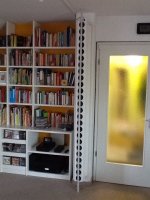
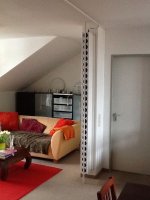
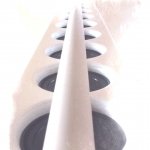
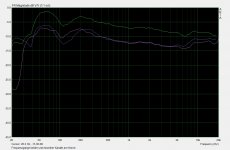
The surround settings did not change the depth or width of my sound stage either, but it did bring it out more. I will try it with Avebury to see if it performs in a similar fashion.
I have a close friend who is a big Zappa fan. I will have him bring some of his collection over, as I know the recording techniques on those albums is second to none.
One more thing:
...Relating back to the perception of soundstage. I noticed when playing with the convolutions, I needed to design my filters for the sampling rate of the source material. When ever I "over-sampled" the convolution, I found it made the treble smoother, but the soundstage became a straight line between the speakers, no depth, no width. I tried no convolution and did the up-sampling in the DAC, and the same thing happened. So I do not know if this is an up-sampling deal, or it is my M-Audio DAC not really being good at 96 kHz. I know we were talking about this earlier in this thread, and this is something I observed. I just hope my Buffalo DAC does not do this to the sound when it up-samples. Anyone else observe this?
So having said all of that, and being reaffirmed with many of my discoveries on this thread, I am on a mission to find a driver that has a flawless response between 1 kHz - 6 kHz. I was considering building a full-range ribbon driver, but seeing that it is possible to have a uniform dispersion pattern with 3-4 inch full-rangers, and that someone upgraded from a Magnapan system, maybe I will go that route...
I hope I was able to provide some useful information here...
Allen
Interesting observation Allen,
I'm glad you too liked the JRiver effect. I couldn't get the JRiver team to spill the beans on that and meant to figure it out by running some tests. Leaving it on during a REW sweep raised SPL a bit but nothing harmful in distortion happened. It is a sort of mid/side processing and as such we should be able to figure out how it works. I have the free Voxengo MSED plugin and played with settings there. While it does something similar the JRiver effect sounded better so far.
I also played with up sampling in several ways. My M1 DAC is an upsampling DAC and I can't turn off that feature. At least I haven't found a way yet. That was one of the reasons I wanted to get my Asus Xonar card running without the 50 Hz hum. When I up sampled the convolver file and ran at 96 KHz I got worse results some of the time. As JRiver can upsample (even the convolver can up sample on the fly) I tried to up sample within JRiver to 88.200 prior to sending the signal to the DAC. It's different, that's for sure, but I can't say it's better. More lively high frequency up to the point of sounding harsh on some material. I'll do more tests... I've played both after one another, it didn't mess up my imaging or depth. I did get some sibilance on some material but I have to say I'm really sensitive for that. It would be fun to have more DAC's (and amps) to play with sometimes.
For now I'm going back to native 44.100 for a while and let my DAC up sample. Hopefully I'll be able to clean up the Asus sound card to play with this some more.
Here are photos of both arrays, which are mounted via sorbothane machine mounts in an opposing fashion.
The grey plastic tubing in front of the drivers serves to disperse the highs, which works very effectively but looks awkward.
Then there's the avatar you've mentioned, right?
Lastly there's the frequency responses of each channel and both channels combined, heavily smoothed, since they aren't as smooth as yours. But one gets the downward tilt, which most of us seem to favour.
Cheers
Yes marin, that's the avatar I saw... I immediately got the drift when I saw that tube. I had been thinking about something similar. I wanted to try a sphere in front of the drivers, one each. I figured it would make the path length more even over a wider area for each speaker and combat the comb filtering that way.
I haven't tried it yet. What's your story behind the tubing, what tests did you do and how does/did it work better than without that tube? Is it a solid tube? or is it a type of foam. I've thought about using foam for the sphere, it would slow down the waves going straight through while evening out with signal that goes the longer path around it. One of these days I'd like to get an idea a la Danley (see his work on the Synergy) to be able to get a true line output at higher frequencies while still only using full rangers in the Array.
Interesting for sure.
Last edited:
The grey plastic tubing in front of the drivers serves to disperse the highs, which works very effectively but looks awkward.
Marin,
Is there a "science" involved on how You figured out the diameter and distance (from the drivers) for the gray tubing? (Any links to reading material would be greatly appreciated.)
Did the gray tubing affect the clarity in anyway?
Based on your measurements, this seems like an effective way to create a uniform dispersion pattern.
Thanks for sharing the idea.
Allen
To add to Allen and my question, I'd love to see an impulse and step response from this idea. The smoothing is quite heavy as you mentioned. I get straight lines if I do that  .
.
Here's 1/1 octave smoothing in REW from me (prior to the mentioned PEQ change)
But if it really lifts up the highs like it seems to do it's pretty interesting.
It might even result in me trying the spheres... Oh No
I'll be sure to try and make it look pretty, eventually...
Here's 1/1 octave smoothing in REW from me (prior to the mentioned PEQ change)
An externally hosted image should be here but it was not working when we last tested it.
But if it really lifts up the highs like it seems to do it's pretty interesting.
It might even result in me trying the spheres... Oh No
I'll be sure to try and make it look pretty, eventually...
Last edited:
There's not that much science behind the tubing, I'll have to disappoint you...
It's just standard 25 mm PVC installation tubing, other diameters seemed out of proportion. No fancy filling like foam or sand, but they're suspended from the arrays and I can't make out any detrimental resonances from them.
Background:
I had opted to subordinate my HiFi to family needs - after all, it's our all-in-one room and my girls kindly put up with the T4A's taking up a lot of walking space for many years.
So I mounted the arrays where they seemed to be at an acoustically favorable position, minus any fancy swiveling mechanism.
Due to increasing horizontal beaming toward high frequencies, I needed some counter measure for my preferred equilateral listening position, and voilà, came up with the cheap to try tubing option.
After some measuring and slight adjustments in the lower highs, they just stayed where they were, since they did fit the bill.
Due to their sub-optimal visual appearance I recently removed the tubing, but still am less enthusiastic about the sonic result, which can't be fixed by eq.
None of the sonic attributes I crave suffer from the tube-approach, so I need to figure out a visually more appealing solution eventually...
The soundstage is usually wider than the arrays' positions suggest and it's depth reaches from about halfway between them and my ears to well behind the room's boundaries, some 3 meters away from them, to as far away as the recording seems to demand.
When walking around the room, the positioning and radiation pattern of the arrays mitigate the sound stage collapsing problem usually encountered with standard loudspeaker placement.
See pictures of both arrays' combined as well as their individual step responses from the equilateral listening position.
It's just standard 25 mm PVC installation tubing, other diameters seemed out of proportion. No fancy filling like foam or sand, but they're suspended from the arrays and I can't make out any detrimental resonances from them.
Background:
I had opted to subordinate my HiFi to family needs - after all, it's our all-in-one room and my girls kindly put up with the T4A's taking up a lot of walking space for many years.
So I mounted the arrays where they seemed to be at an acoustically favorable position, minus any fancy swiveling mechanism.
Due to increasing horizontal beaming toward high frequencies, I needed some counter measure for my preferred equilateral listening position, and voilà, came up with the cheap to try tubing option.
After some measuring and slight adjustments in the lower highs, they just stayed where they were, since they did fit the bill.
Due to their sub-optimal visual appearance I recently removed the tubing, but still am less enthusiastic about the sonic result, which can't be fixed by eq.
None of the sonic attributes I crave suffer from the tube-approach, so I need to figure out a visually more appealing solution eventually...
The soundstage is usually wider than the arrays' positions suggest and it's depth reaches from about halfway between them and my ears to well behind the room's boundaries, some 3 meters away from them, to as far away as the recording seems to demand.
When walking around the room, the positioning and radiation pattern of the arrays mitigate the sound stage collapsing problem usually encountered with standard loudspeaker placement.
See pictures of both arrays' combined as well as their individual step responses from the equilateral listening position.
Attachments
Just realised, that all the measurements were taken, before I replaced my Texas Instruments Digital Signal Processor Evaluation Board, with which I originally eq'ed the arrays, with the Behringer.

Haven't done any ARTA measurements since the Behringer came in and after using it's integral noise generator, mic input and analyser to eq the arrays.
Intended to do so eventually, but am so happy with the sound, that I rather spend my time listening...

Just a pic of a 1/12th octave smoothed measurement and one of the Behringer in the system...
Haven't done any ARTA measurements since the Behringer came in and after using it's integral noise generator, mic input and analyser to eq the arrays.
Intended to do so eventually, but am so happy with the sound, that I rather spend my time listening...
Just a pic of a 1/12th octave smoothed measurement and one of the Behringer in the system...
Attachments
Could a thinner tube be placed closer to the front of the array?
Trying to think space and perspective here. If a bigger tube is placed away, perhaps a thinner tube, held in place closer to the arrays drivers would work the same way?
I determined the optimum distance of the 25 mm tube to be about 1 cm from the baffle by measuring treble extension at the listening position. Too far away or too close and the dispersion effect there is gradually lost.
The next smaller tube diameter of 10 or 12 mm seems to suffer from the extrusion process and storage conditions to render the tubing out of shape. It would look even more awkward against the straight shape of the arrays, so I didn't even try. Other materials were too costly to just try...
I should actually use a single chassis in an appropriately shaped box to experiment with different tubing material and diameters, while being able to measure in a 180° arc in the nearfield without the disturbance of near-by surfaces and different arrival times from the differently spaced chassis relative to the microphone.
Wow, looks like quite a task!
Rather go and listen to some more music for now, until I start being less content with the sound...
But hey, wait!
Wesayso has just the right test object built already to do just that, doesn't he?
- Home
- Loudspeakers
- Full Range
- The making of: The Two Towers (a 25 driver Full Range line array)
